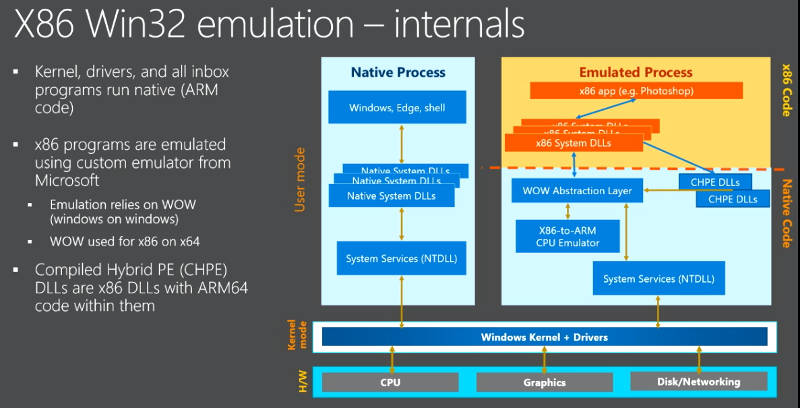| Windows 10 On Arm Runs Win32 Apps |
| Written by Mike James |
| Friday, 12 May 2017 |
|
One of the biggest, but largely unnoticed, announcements at BUILD 2017 is all about a "new" version of Windows 10 that runs on ARM architecture and can run Win32 apps. It is difficult to say exactly how important this is because there is no information on what Microsoft intends to do with this new version of Windows. It is even strange the way that it was "let out" rather than announced via a Channel 9 video. This means it might never see the light of day or it could be a revolution in where you find Windows. This isn't the first version of Windows that works on ARM architecture. The ill-fated Windows RT was designed to work on low-cost ARM hardware, but it had big problems. First it was part of the Windows 8 fiasco and was doomed by association with its big brother. It was also at a disadvantage because Microsoft restricted what you could use it for. You could run Office and a few other big applications that Microsoft had installed, but after that it was Store apps - or Metro apps as we called them then - or nothing. The big problem was that Metro apps were in short supply and what people really wanted was Windows proper. Windows RT failed miserably. You could say that Windows 10 S resurrected the spirit of Windows RT in that this is a full Windows 10 but it only allows its users to install apps from the app store. It is still to be seen if this is going to be something that puts users off from this low cost alternative. What it the real surprise is that Windows 10 on ARM has resurrected Windows RT in a bigger way in that it runs on ARM architecture. It too will run Windows Store apps but, and this is an even bigger surprise, it will run Win32 apps as well.
What this means is that you could in theory buy an ARM tablet with Windows 10 on ARM and use it to run standard Win 32 apps. What is more, the apps don't have to be modified in any way. You simply install them in the usual way and the system software does the magic. It is claimed that this works by translating the x86 instruction to ARM64 at runtime. To speed things up these are cached on disk for future use. In the old days this used to be called cross-compiling machine code, but it isn't exactly clear what is going on here. A lot of the time the system is running native ARM code as part of the kernel and drivers. Take a look at the video:
What is clear is that the software is based on the assumption that more powerful ARM processors, such as the Qualcomm Snapdragon 835, which should be available later this year, will make Windows on ARM fast enough. In the video it is claimed that devices running the 835 and Windows 10 on ARM will be available later in the year. While there are quad-core Intel-based Android tablets, Microsoft was counting on using Intel Atom chips that were cancelled in the middle of 2016. The current Atom chips are starting to look underpowered and it could be that Microsoft has turned to the 835 to keep its mobile hopes alive. At the end of the day, users really don't care if the hardware they use is ARM or Intel or something else. All they really care about is price versus performance. If Microsoft hopes to get Windows 10 on ARM into users hand they have to deliver hardware that is cheaper than a Chromebook or a quad-core Android Tablet, say $150, with enough power to run all Windows apps. This seems to be a difficult target. Add to this the fact that the 835 is in short supply, because, supposedly, Samsung bought them all for its phones. It may be that Windows 10 on ARM is too late to make a difference.
More InformationRelated ArticlesIs The Future Of Windows RT In Doubt? Windows 8.1 No Longer Supported - UPDATE Microsoft Reveals "Universal" Apps
Developers - Microsoft Is Back! Windows 8 Users Hardly Use Any Modern Apps How Microsoft Could Have Done Metro
To be informed about new articles on I Programmer, sign up for our weekly newsletter, subscribe to the RSS feed and follow us on Twitter, Facebook or Linkedin.
Comments
or email your comment to: comments@i-programmer.info |
| Last Updated ( Friday, 12 May 2017 ) |




